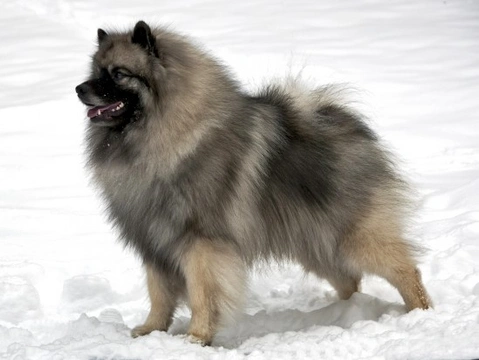
Hereditary health and health testing for the Keeshond dog breed
The Keeshond is a medium sized dog breed of the spitz type, which was historically called the Wolfspitz or German spitz, and colloquially, the Dutch Barge Dog. The breed originated in Germany, and is related to both the Pomeranian and various other German spitz dog breeds.
Dogs of the breed can stand up to 18” tall at the withers, and weigh up to 20kg. Males tend to be larger than females, and the breed should possess the typical spitz dog appearance, with a curled tail, pointed ears and thick coat.
The coat of the Keeshond is thick and double layered, with an even thicker ruffle of hair around the neck. The undercoat is downy and dense, while the top coat is straight and harsh, providing extra warmth and protection. The coat colour is a mixture of black and grey, with a cream or grey undercoat and the hairs of the top coat being tipped in black. While the colour guidelines for the breed are fairly strict, they may range in shade from fairly light to quite dark within the accepted norms. Facial markings in the shape of glasses may be present around the eyes.
If you are wondering if the Keeshond is the right choice of dog for you, it is of course important to do plenty of research into the breed before committing to a purchase. This includes finding out about the general hereditary health of the breed, and if any pre-breeding health screening is advised. We will look at these factors in more detail within this article.
Keeshond average longevity
The average lifespan for dogs of the breed as a whole is 12-14 years, which places them towards the top of the rankings across the board of all breeds of a similar size and build. This indicates that the Keeshond tends to be a robust and healthy dog, and not one that is plagued with a wide range of health problems.
Genetic diversity within the breed
The coefficient of inbreeding statistic for the breed is 6.6%, which is just a touch higher than the 6.25% or less that is considered to be the ideal for pedigree dog breeds. This indicates that some degree of inbreeding is present within the Keeshond breed pool, but that it does not pose a major problem. Keeshond breeders should seek to reduce the coefficient of inbreeding statistic within their own breed lines where possible.
Conformation
The shape and build of the Keeshond is generally considered to be robust and well balanced, and not apt to cause any particular problems for the dog in and of itself. However, the thick, dense coat of the breed does mean that they may be prone to overheating in hot weather, and care should be taken during the summer months to ensure that dogs can stay cool enough.
Health testing for the Keeshond
The British Veterinary Association and the Kennel Club recommend a couple of pre-breeding health tests for potential parent dogs of the Keeshond breed, in order to ensure the good health of the resulting puppies. Such tests are:
- Hip score testing, with the mean score across the breed as a whole being 12. Potential parent dogs should receive a hip score below this level to be considered as good candidates for breeding.
- DNA testing for primary hyperthyroidism, an excessive production of the thyroid hormones. This can lead to ultimate renal failure due to high calcium levels in the blood, and is an autosomal dominant trait within the breed.
Other health issues
The Keeshond breed as a whole is considered to be a healthy one that is not plagued by a wide range of hereditary health problems, or widespread predispositions to particular problems. However, as well as the conditions listed above, there are a small number of other hereditary health conditions recognised within the Keeshond breed, but not at such a rate that standard testing is recommended. Such conditions include:
- Hereditary epilepsy, with dogs known to have epilepsy not being considered as viable for breeding. However, epileptic dogs can often lead a generally healthy life and normal lifespan when their condition is controlled with medication.
- Type one diabetes, due to an underproduction of insulin by the pancreas. Dogs that are diagnosed as diabetic will require supplementary insulin administration for life.
- Squamous cell carcinoma, a cancer of the skin is also known to occur across certain Keeshond breed lines.
- Alopecia, a hair loss disorder caused by a hormonal imbalance is also present within some dogs of the breed, leading to loss of the coat in patches.
- A couple of different cardiac conditions are also recognised, being hole in the heart or ventricular septal defect, and also patent ductus arteriosus, a condition where the blood is incorrectly circulated around the body.



